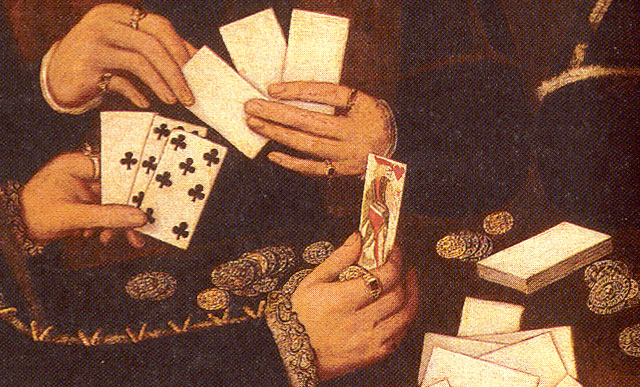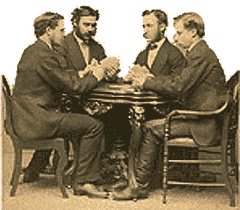History of Blackjack
Over the years the origin of Blackjack, like many other games, has eluded researchers for a long time and which continues to be hotly debated to this day.
 ver the years the origin of Blackjack, like many other games, has eluded researchers for a long time and which continues to be hotly debated to this day. Till date there has been no clear consensus, but most agree it probably originated in French casinos around 1700, where it was called Vingt-et-Un which, translated, means twenty-one. Most believe it was probably derived from the French card games, Chemin de Fer, and French Ferme, which were in vogue at that time.
ver the years the origin of Blackjack, like many other games, has eluded researchers for a long time and which continues to be hotly debated to this day. Till date there has been no clear consensus, but most agree it probably originated in French casinos around 1700, where it was called Vingt-et-Un which, translated, means twenty-one. Most believe it was probably derived from the French card games, Chemin de Fer, and French Ferme, which were in vogue at that time.

Another of its version was prevalent in Spain, which was called 'One and Thirty'. The basic rule of the Spanish version was to reach 31 with a minimum of three cards.
A theory that’s also doing the rounds is that Blackjack was an invention by the Romans. It is believed that Romans used to play this game with wooden blocks of different numerical values. This theory holds some weight as Romans loved gambling, but that by no means confirms the theory.
Among the various versions of the game, 'Vingt-et-Un’ or ‘21’ continued to grow in popularity and reach. It gradually spread to North America thanks to French colonists and soon after it was played throughout the continent. The rules of Blackjack were then different from those of modern or contemporary Blackjack. Just to elaborate, in this form of Blackjack, only the dealer was permitted to double. Also, a betting round was there between each of the playing cards dealt.
 The game was still termed ‘21’ when it gained popularity in Nevada in 1931 as the State first chose to make gambling legal. To draw more people to the game, some casinos then offered a special bet: A hand featuring either of the black jacks (the Jack of Spades or that of Clubs) plus the Ace of Spades would pay 10-to-1 odds on the lucky player’s bet. Although casinos later discontinued this peculiar payout, the name ‘blackjack’ or ‘black jack’ remained, as the game is known today.
The game was still termed ‘21’ when it gained popularity in Nevada in 1931 as the State first chose to make gambling legal. To draw more people to the game, some casinos then offered a special bet: A hand featuring either of the black jacks (the Jack of Spades or that of Clubs) plus the Ace of Spades would pay 10-to-1 odds on the lucky player’s bet. Although casinos later discontinued this peculiar payout, the name ‘blackjack’ or ‘black jack’ remained, as the game is known today.
Five of Clubs: “Watson’s card”. The name has nothing to do with Sherlock Holmes but refers to a famous gambler who is supposed to have won £10,000 at Faro through his wager in connection with this card.
Blackjack was not conceived by any one person at one definite point of time. On the contrary, blackjack has evolved over centuries; it continues to evolve and grow even today, thanks to the Internet. Fuelling its popularity the online casino industry has developed various versions of the game which has truly revolutionized it.
Now a few reputed casino operators have started an innovative and far more enjoyable concept of this game: live blackjack game with real dealers. Live Blackjack is the most advanced way to play your favourite casino game right in the comfort of your home, without having to go a long way to a field-based casino.
Sources:

By Simon Wintle
Member since February 01, 1996
I am the founder of The World of Playing Cards (est. 1996), a website dedicated to the history, artistry and cultural significance of playing cards and tarot. Over the years I have researched various areas of the subject, acquired and traded collections and contributed as a committee member of the IPCS and graphics editor of The Playing-Card journal. Having lived in Chile, England, Wales, and now Spain, these experiences have shaped my work and passion for playing cards. Amongst my achievements is producing a limited-edition replica of a 17th-century English pack using woodblocks and stencils—a labour of love. Today, the World of Playing Cards is a global collaborative project, with my son Adam serving as the technical driving force behind its development. His innovative efforts have helped shape the site into the thriving hub it is today. You are warmly invited to become a contributor and share your enthusiasm.
Related Articles

French Revolutionary cards by Pinaut
Seven cards from a French Revolutionary pack by Pinaut featuring characters from classical antiquity...

Rouen Pattern - Portrait Rouennais
An attractive XV century French-suited design from Rouen became the standard English & Anglo-America...

Ganjifa - Playing Cards from India
Indian playing cards, known as Ganjifa, feature intricate designs with twelve suits and are traditio...

The Henry Hart Puzzle
Explore the intricate history and unique design variations of Henry Hart's playing cards, tracing th...

Sevilla 1647 reproduction
Facsimile of Spanish-suited pack produced in Sevilla, Spain, 1647.

Why our playing-cards look the way they do
Analysis of early playing card designs: origins, suit differences, standardization, technological ad...

Introduction to Collecting Themes
Playing cards can be broadly categorised into standard and non-standard designs, with collectors app...

Le Monde Primitif Tarot
Facsimile edition produced by Morena Poltronieri & Ernesto Fazioli of Museo Internazionale dei Taroc...

75: Early American cards
An overview of some of the early cards made in the United States.

Early German playing cards
Some early examples of popular German playing cards from the XV and XVI centuries.

The Parisian Tarot
The “Parisian Tarot”, early 1600s, with imagery and design synthesizing several influences.

73: Fakes, Forgeries and Tax Evasion
When there are official taxes to pay, people will find a way to avoid paying them - often illegally....

Russian Playing Card History - From the Beginnings to 1917
An in-depth review of the history of card-playing, gambling, legislation, manufacture and taxation o...

Russian Playing Card Monopoly
The Russian Playing Card Monopoly was established in March 1798 with all revenue going to support th...

Trappola cards from Prague
15 Trappola playing cards possibly made by Johann Ziser of Prague, c1760.

Languedoc pattern - Portrait de Languedoc
The old Languedoc pattern was known at the beginning of the seventeenth century, if not before.
Most Popular
Our top articles from the past 28 days

